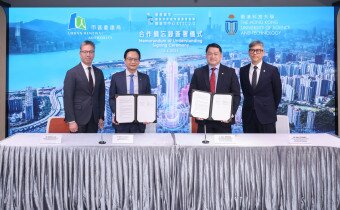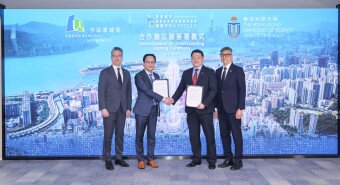


URA and HKUST Sign Memorandum of Understanding
The Urban Renewal Authority (URA) and The Hong Kong University of Science and Technology (HKUST) signed a Memorandum of Understanding (MOU) today (3 June 2025), establishing a co-operative intent and framework for the HKUST to expand its off-campus education and research space in the non-domestic portion of the URA’s Kwun Tong Town Centre 2.0 project (KTTC 2.0, or the Project) upon its completion.
The MOU was signed by Managing Director of URA, Ir Wai Chi-sing, and Vice-President for Development of HKUST, Ir John Kwong. Under the co-operative framework, HKUST intends to take up certain non-domestic portion of the Project, upon completion, either through purchase or other means, to support its development needs. The additional off-campus space will help achieve the development goals of advancing education and research, promoting innovation and technology development, and strengthening Hong Kong’s position as a global leader in technological innovation. The URA will make full use of the Project’s strengths to achieve the development goals of both parties.
The URA believes that this strategic co-operation highlights the unique features of KTTC 2.0, particularly its diversity, versatility and connectivity. With the landmark building that can reach a maximum height of 360 metres, the Project will emerge as Hong Kong’s first high-density composite development with the “Vertical City” concept that integrates commercial and residential spaces. Located in the Central Business District (CBD) on the Eastern side of Hong Kong, KTTC 2.0, along with One Island East across the harbour, will define the Eastern Gateway of Victoria Harbour, echoing the Western Gateway marked by the International Finance Centre in Central and the International Commerce Centre in West Kowloon.
KTTC 2.0 includes three key competitive advantages:
- Super high footfall: The Project is situated in Kwun Tong Town Centre, the most densely populated area in Hong Kong, which boasts a large workforce and residential population. Connecting Kwun Tong business area in the south and the residential area in the north, the Project is poised to become a central hub for pedestrian flow, logistics, and economic activities, fostering vibrancy around the clock.
- Exceptional accessibility and connectivity: Seamlessly connected to Hong Kong’s first air-conditioned Public Transport Interchange and Kwun Tong MTR Station, the Project provides quick access to other core districts of Hong Kong Island and Kowloon. Elevated footbridges will connect the Project with the business area in the south, complemented by a multi-level pedestrian network to be developed within the Project and its vicinity. This network will link the Civil Service College, Kwun Tong MTR Station, and Millennium City 5, establishing the Project as a super connector among the main transport hubs and activity nodes in the district.
- Great planning and design flexibility: To better accommodate prevailing market conditions and demand, the Project allows the flexibility to interchange the ratio of development mix among hotel, office and commercial uses in the non-domestic gross floor area of over 1.5 million square feet under the “Floating Planning Parameters” without the need to obtain additional planning approval, whether during development stage or after the Project’s completion. This arrangement greatly enhances the Project’s development potential and agility.
This co-operation between the URA and HKUST underscores the competitive advantages of the “Vertical City” development, which promises the integration of multiple functions, including “commercial, residential, trading, tourism, education and research” in the Project. With the benefits of urban renewal being elevated from the district level to visionary areas, the Project is expected to offer highly flexible spaces for the current and future development of various industries in Hong Kong.
Upon the completion of KTTC 2.0, HKUST could utilise the secured space for teaching, research, or office purposes, catering to its development needs. Over the past few years, HKUST has been implementing various campus development plans to meet its future needs. In addition to establishing the region’s most advanced artificial intelligence computing centre in late 2023, several key education and research buildings will be completed in the near future, providing more advanced facilities and research space for students and staff.
The URA seeks to attract a diverse array of industries to the Project to address different needs and support Hong Kong’s long-term development goals. Emerging as a new landmark in Hong Kong’s Eastern CBD, KTTC 2.0 will integrate commercial, trade and economic activities with a robust transportation network, thereby enhancing the accessibility and functional diversity of the development of a world-class Victoria Cove Area.
To expedite the Project and further enhance its attractiveness, the URA plans to introduce Development Facilitation Services for the Project in the second half of this year. This initiative will provide interested developers ample time to review project details before the tendering process begins. Additionally, it will allow the URA to gather feedback from developers to mitigate uncertainties and optimise the tender terms. Furthermore, the underground utilities diversion works for the Project are scheduled to begin in the third quarter of 2025. The timing aims to minimise the preliminary work required by the future successful tenderer, thereby accelerating progress and reducing construction risks.
(ENDS)
